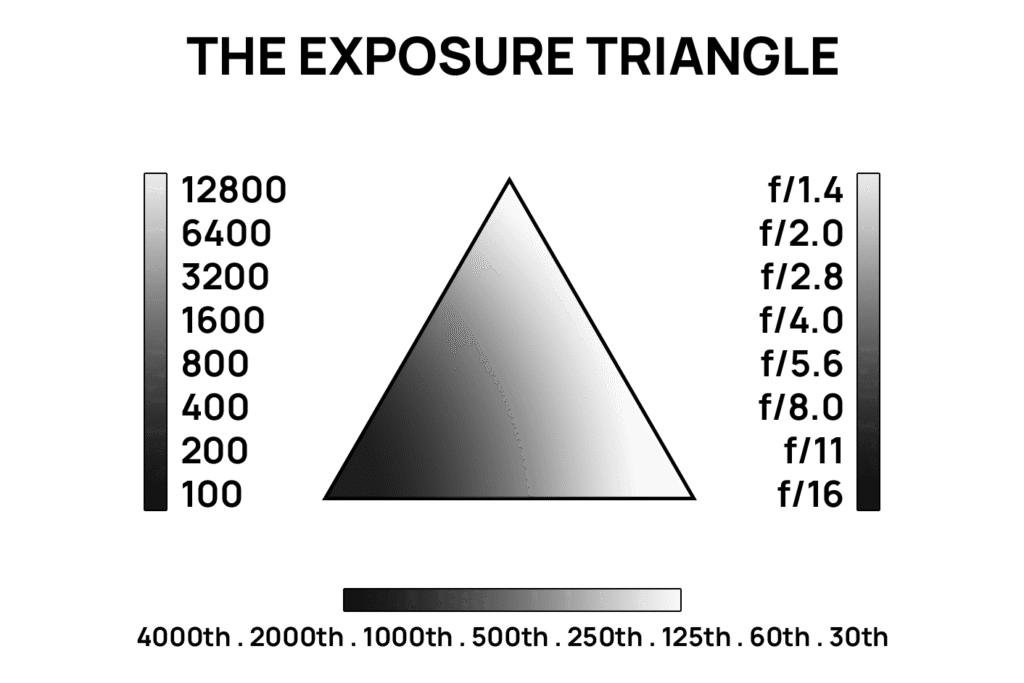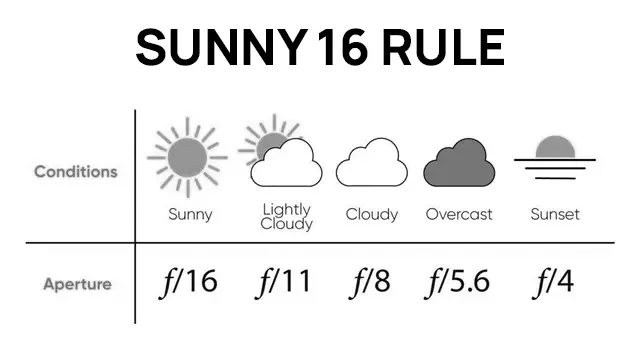
IMAGE TOO DARK ?
[+] use a higher ISO
[+] use a wider aperture
[-] reduce shutter speed
IMAGE TOO BRIGHT ?
[+] increase shutter speed
[-] use a lower ISO
[-] use a smaller aperture

📷 What is the Exposure Triangle?
The Exposure Triangle refers to the relationship between three camera settings:
Aperture (f-stop): Controls how wide your lens opens — affects depth of field.
Shutter Speed: Controls how long the shutter stays open — affects motion blur.
ISO: Controls your camera’s sensitivity to light — affects brightness and image noise.
Changing one setting will require an adjustment of at least one other to maintain the same exposure.
🔺 The Triangle in Practice
Aperture
f1.4
f2
f2.8
f4
f5.6
f8
f11
f16
Shutter Speed
8000
4000
2000
1000
500
250
125
60
ISO
100
200
400
800
1600
3200
6400
12800
EXAMPLE 1
Let’s say you’re working in a fixed lighting environment, it’s an overcast afternoon at an outdoor wedding. You’re shooting in manual and your ISO is set to 100 – You want to open up your aperture to add some subject separation background blur.
You change your aperture from F5.6 to F2.8 (allowing in + 2x stops of light). To maintain your original exposure you must find a way of reducing 2x stops of light. You can do this by increasing your shutter speed and/or lowering your ISO.
5.6 @ 500th @ ISO100
2.8 @ 2000th @ ISO100 (shutter speed adjusted -2 stops)
2.8 @ 1000th @ ISO200 (shutter speed and ISO adjusted -1 stop each)
EXAMPLE 2
If you were to keep your aperture at f/2.8, but move from bright daylight into a dimly lit barn, you might need to increase your ISO or slow your shutter speed in order to correctly expose again.
In this scenario, imagine the dimly lit barn is 5x stops darker than it was outside…
2.8 @ 1000th @ ISO200 (outside)
2.8 @ 500th @ ISO3200 (inside) shutter speed +1 stop, ISO +4 stops
2.8 @ 125th @ ISO800 (inside) shutter speed -3 stops, ISO +2 stops
Both options give the exact same exposure but prioritise different things (shutter speed or ISO).
☀️ The "Sunny 16" Trick

The Sunny 16 rule is a method for estimating correct daylight exposures without a light meter.
It’s a simple rule of thumb that helps you set your aperture and shutter speed for a bright, sunny day.
It provides a starting point for your exposure settings.
Conclusion
Whether you’re capturing motion or have your camera set on a tripod, you will prioritise different settings to get a correct exposure. Think of the triangle as a seesaw – push one side down, and you’ve got to lift the others. Mastering this gives you the flexibility to shoot in any lighting condition without missing shots.
